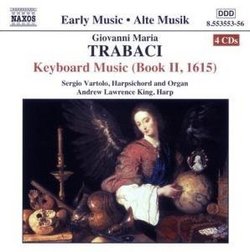| All Artists: Trabaci, Vartolo, King Title: Keyboard Music (Book II 1615) Members Wishing: 0 Total Copies: 0 Label: Naxos Release Date: 2/18/2003 Album Type: Box set Genre: Classical Styles: Chamber Music, Historical Periods, Classical (c.1770-1830) Number of Discs: 4 SwapaCD Credits: 4 UPC: 730099455329 |
Search - Trabaci, Vartolo, King :: Keyboard Music (Book II 1615)
 | Trabaci, Vartolo, King Keyboard Music (Book II 1615) Genre: Classical
|
Larger Image |
CD Details |
CD ReviewsRare early Italian baroque keyboard music J Scott Morrison | Middlebury VT, USA | 04/17/2003 (4 out of 5 stars) "This 4CD collection from Naxos is the second installment of keyboard music by the early Baroque Italian composer Giovanni Maria Trabaci (c. 1575-1647). It is, as far as I know, the first recording of the Book II (1615) of his keyboard music. His music is not widely known by music-lovers at least partly because there was no modern edition of this music until recent years. The early editions were printed in four-stave open score using archaic notation, making it difficult for performers to play, even those who specialize in the music of the era. This set's primary performer, Sergio Vartolo, is something of a specialist in Trabaci's music and he plays on several different organs, harpsichords and even an 18th-century Italian spinettone. There are also some pieces played by the harpist Andrew Lawrence King. The variety in tonal color amongst the various instruments tends to obviate monotony in the almost four hours of music presented here. The various instruments employed are enjoyable, although there is a particularly irritating 'usignuoli' ('nightingales') stop on one of the organs; fortunately it is used sparingly. Trabaci was a renowned organist and composer from Naples; he was the organist of the Chapel Royal there during a period when Naples was under Spanish rule. He is a contemporary of the much-better-known Girolamo Frescobaldi (1583-1643) of Venice. Both he and Frescobaldi were masters of the rather severe late-Renaissance/early-Baroque contrapuntal style passed down from Flemish masters. If anything, Trabaci's music is darker and more chromatic than that of Frescobaldi.The first CD contains twelve 'ricercate' (the old term for 'ricercare', a forerunner of the fugue) which display Trabaci's ability not only to write expert contrapuntal pieces, but to devise memorable themes.The next two CDs contain the 'Centi Versi sopra li Otto finali Ecclesiastici' ('100 versets on the eight ecclesiastic finals'). Each 'verset' is accompanied by the appropriate Gregorian chant, in this set sung exquisitely by countertenor Michel van Goethem.The last CD contains assorted other pieces in various forms - toccatas, galliards, partitas - including a setting by Jacob Arcadelt (sung by tenor Mario Cecchetti) of 'Ancidetemi pur,' preceded by a Trabaci setting played on the harp by Andrew Lawrence King, and afterwards by the same setting played on harpsichord by Vartolo.Vartolo's playing is generally expert, but I was bothered somewhat by what seemed to me a rather capricious use of rubato. Since Vartolo is a musicologist it may be that he is using performance practice of the time, and my criticism reflects my own ignorance of that issue. It is very likely that these will be the only recordings of this music for years to come. So, if you feel impelled to explore this rather obscure byway, I would suggest you buy this set (as well as the set containing Book I from 1603), because it's not likely you'll have others to choose from any time soon. And, of course, Naxos's budget price makes these sets eminently affordable.Scott Morrison"
|

 Track Listings (12) - Disc #1
Track Listings (12) - Disc #1